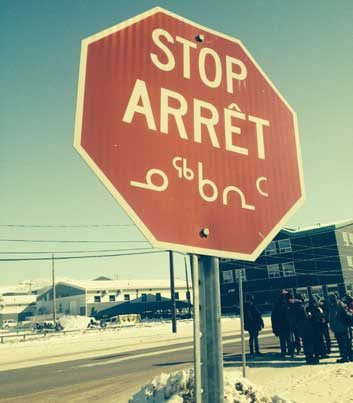A View From Nunavut. Kids & Food: Day 1 & 2
On Saturday, as I walked onto the tarmac in Ottawa to fly North to Iqaluit en route to Cape Dorset,

On Saturday, as I walked onto the tarmac in Ottawa to fly North to Iqaluit en route to Cape Dorset, I snapped a picture of the airplane to send to my 2 ½ year old son who is obsessed with planes.
I have no idea what to expect in Nunavut. I’m traveling to Cape Dorset as part of EatFit, the brainchild of Paul Finkelstein, one of Best Health’s regular recipe contributors and a former Food Network star of the show ‘Fink’. The chef and teacher at Stratford Northwestern Secondary School has long been on a mission to teach kids healthy eating habits through learning to cook. Paul has assembled a team that includes some of his high school students to travel North to share food and culture for a week. Our posse is diverse’it also includes entrepreneurs and a carpenter, and I’m here in my capacity as a fitness expert (more on that in a future blogpost)’and most of us have never been north of the tree line.

That’s the first thing you notice as the plane descends into Iqaluit, where we have a four-hour layover: no trees, and blinding whiteness. It is cold as we trek through town with our guide, Aaron Watson, a native of Stratford, Ont., who is married to an Inuit woman and moved to Nunavut ten years ago. He is a wealth of knowledge, pointing out the new church, shaped like an igloo, and sharing facts and figures about the capital. Stop signs are in three languages; there are no streetlights. At the gas station, snowmobiles fill up their tanks; children in open sweatshirts sled down makeshift hills, because to them, it is spring. Me, I wonder if my nose is on the cusp of frostbite.

Aaron takes us to the grocery store so we can check out the prices, something that has practically become a form of tourism in Iqaluit. There has been much reported on the high cost of food in the North, and food insecurity for Inuit children made headlines again last week. Children do go hungry, and food prices are a huge problem. The prices are startling: a box of Cheerios is over $8, a 12-pack of pop will cost you $15; a tin of tomatoes will set you back $4. Staples like milk and eggs are not exorbitant, but do cost more than in the South.
In the Visitor’s Centre, filled with art and stuffed caribou and polar bears, we are treated to a performance by two young throat singers ‘ what National Geographic calls a ‘unique and a traditional form of musical expression.’ The beautiful Inuit women hold arms in an embrace, looking into each other’s eyes, and make sounds with the back of their throat, simulating mosquitos, birds, huskies. The game is to see who will break into laughter first. It is unlike anything I have heard before, and each time one of them erupts into giggles we do, too.
We say goodbye to Iqaluit and board a propeller aircraft for Cape Dorset. A blizzard might prevent us from landing; nervous glances are shared. But all goes smoothly, and we are greeted warmly by Mike Soares, the principal of Peter Pitseolak High School, who brings us to our new home for the next week. As part of the adventure we are all living in the school. A group of Inuit girls drags our bags to the classrooms, and I’m struck at how sweet, friendly and outgoing they are. They tell us there is a dance in town tonight: Will we be coming?
We’ve been here a few minutes and we already have a dance ticket.
The girls tell us not to worry about going out at 10pm. ‘There is no bedtime here,’ Mike tells us. ‘You may have kids tapping on the window while you are sleeping, at 1a.m. Just ignore it.’
As we head to the dance’picture a darkened community centre, blasting electronic music, kids with amazing dance moves’the Stratford students throw themselves right into it, pulling kids into a circle, and it is a party. A Top 40 tune comes on and everyone screams. Two little girls tug on Fink’s arm and point to Stephanie Roth, one of the Eat Fit team, ‘Is that Stephanie?’ Steph did a cooking class via Skype a few months ago, and is a celebrity.
Young boys surround Jules, a Toronto carpenter originally from England, and ask him about his accent; a hip-hop dancer who looks to be about 8 years old does crazy moves for Jenny, an L.A.-based Canadian photographer. What strikes me most is how outgoing these kids are; Kinngaitmui (the Inuktitut name for Cape Dorset locals) welcome us with their smiles.
Day 2: Food, glorious food
When I choked at the $5.99 a pound Mike paid for oranges, he was quick to retort: ‘Welcome to the thousand-mile diet.’
To my eye, having been here a matter of 36 hours, food prices seem random and arbitrary. As my friend Joshna Maharaj, a chef and food activist who is here with the EatFit group, posted on Instagram, a sack of flour here will cost you $25′ but you can buy a cake mix for $4. A large pizza is $15, and I saw two frozen steaks on sale for $5. A jar of raspberry jam sets you back $13.39; a carton of orange juice is about the same. Fortunately, eggs, milk and bread aren’t that much more expensive than at home. And while certain fruits and vegetables are ridiculously expensive, others are only slightly pricier than those in the South.
Mike has been here four years, a transplanted teacher from Cape Breton who, four years ago, decided to come to Nunavut in the twilight of his career. He is passionate and dedicated, and on a Sunday afternoon, he takes me around to the grocery store as he does his weekly shopping for the school breakfast program. When fish, bread, meat and staples go on sale, he stuffs his freezers. Mike has been a teacher for long enough to know what teachers in all parts of Canada know: that kids who are hungry don’t learn. So he spends $17,000 a year in his school food budget for 170 kids, and his school food program is known as one of the best in Nunavut.
Driving through Cape Dorset with Mike, we see the blizzard starting to come in across a landscape of rocky snow-covered hills; at one point we get caught in a snowdrift and have to push the van out. Arriving back at the school we find the gym full of kids playing badminton. Every Sunday the school opens up to students and the community for sports; volleyball will be played later. The Stratford kids and the Cape Dorset kids engage in a big game of hide and seek, laughing and racing through the halls. Meanwhile, I take the opportunity to talk to my daughter on Face Time, and some of the girls here stop what they are doing, take over the conversation, then escape to the library to watch a movie.
At 10pm, it’s time for the 40 kids to go home. This is a moment when I realize how different things are here: there are no permission slips to sign or cars to pick anyone up. The parents here know their kids will get home safely. Nevertheless, a couple of the Stratford students walk some of the kids home.
As the blizzard really sets in, snow starts to covers the windows. We may not have school tomorrow, but I’m told that some kids will show up anyway. If so, Paul will be leading a cooking class to make beef and vegetable stir fry, and I’ll be demonstrating functional movements and running and tag game called Martians and Mushrooms. Just another day in Nunavut.
‘Erin
Follow me on Twitter @erinpp
Erin Phelan is a fitness trainer and mom of two. She’s a regular contributor to Best Health.




